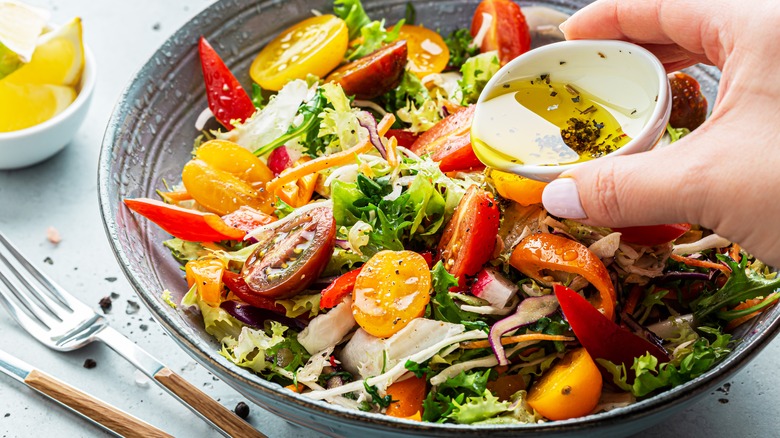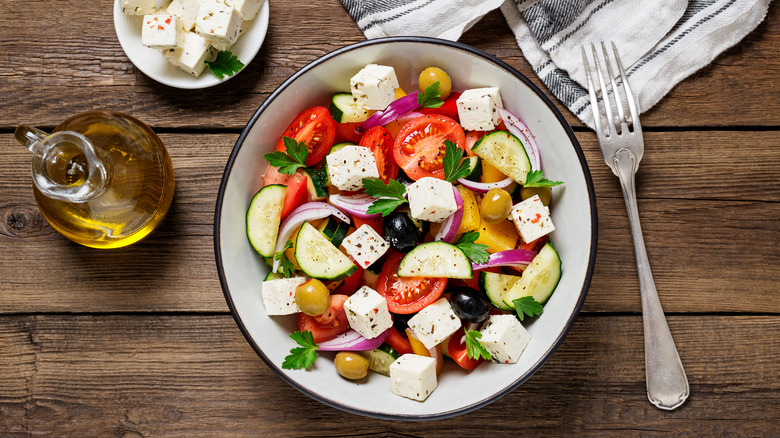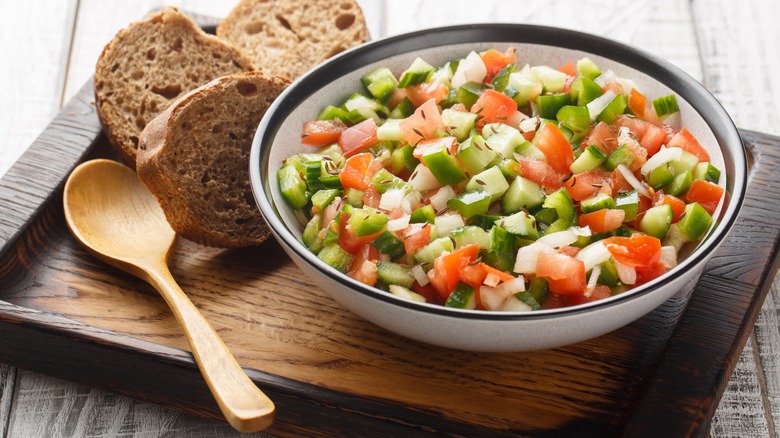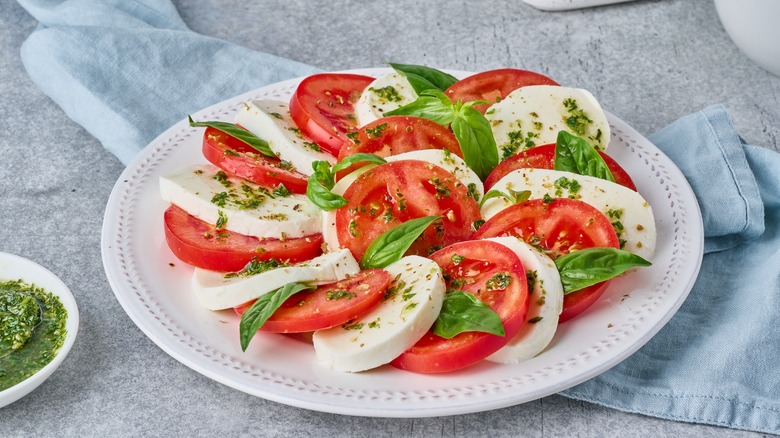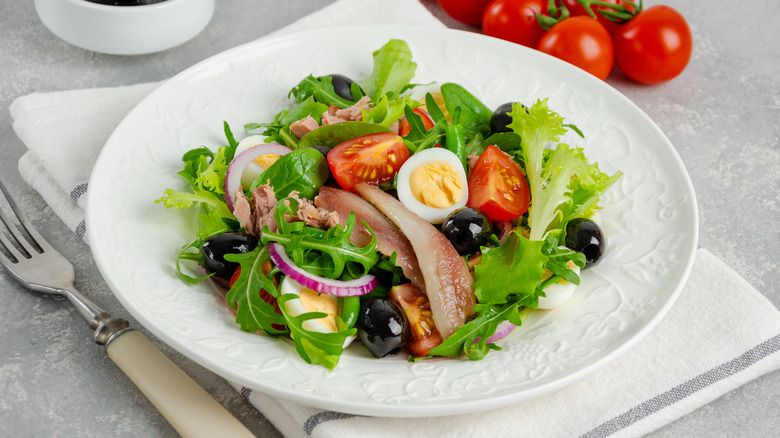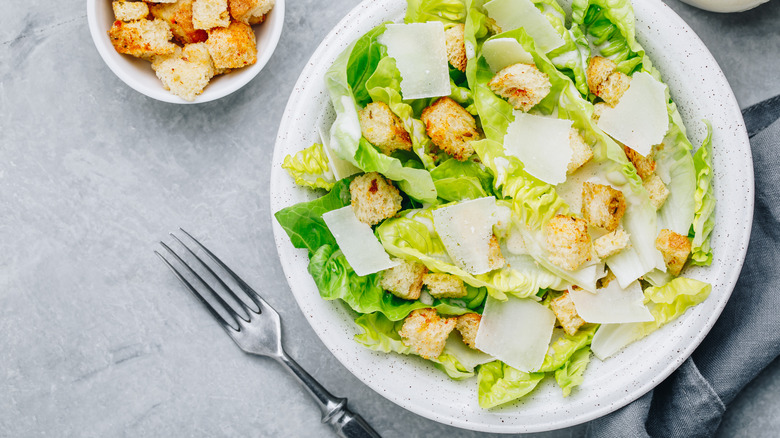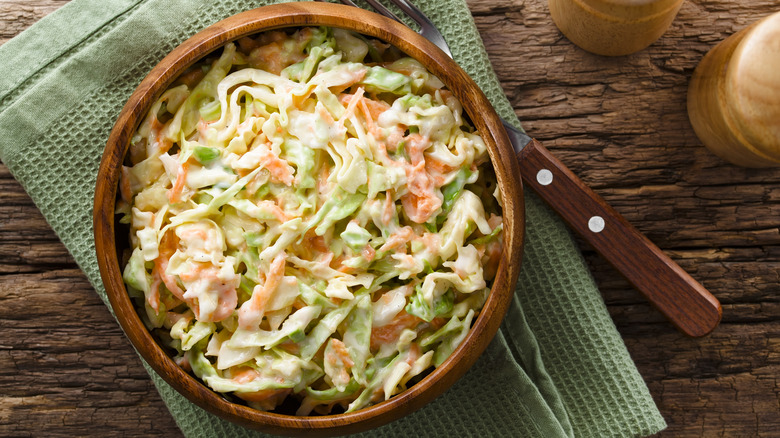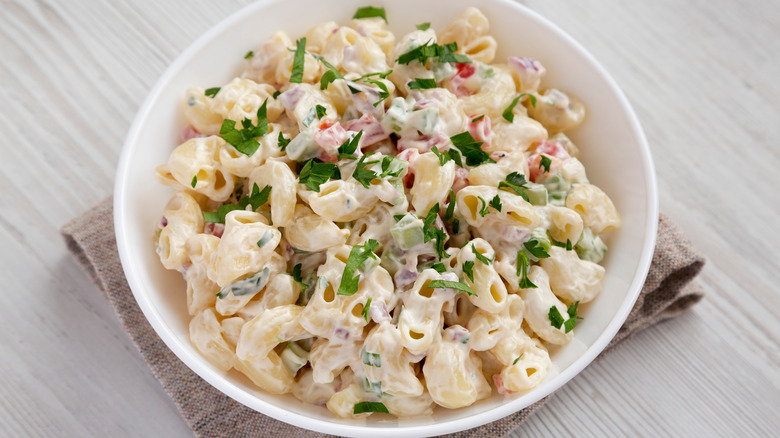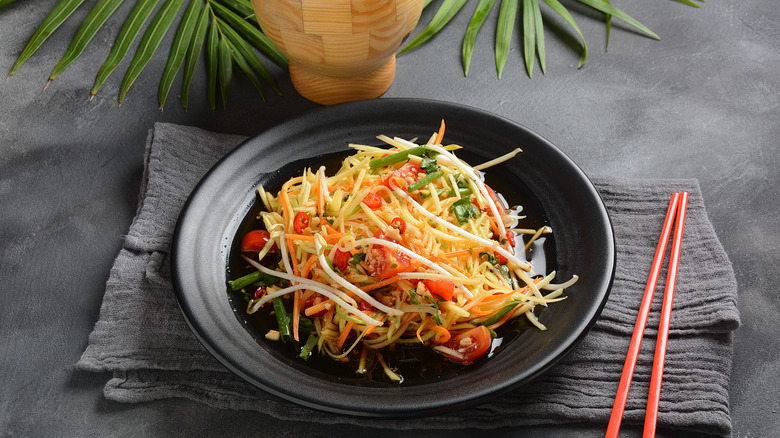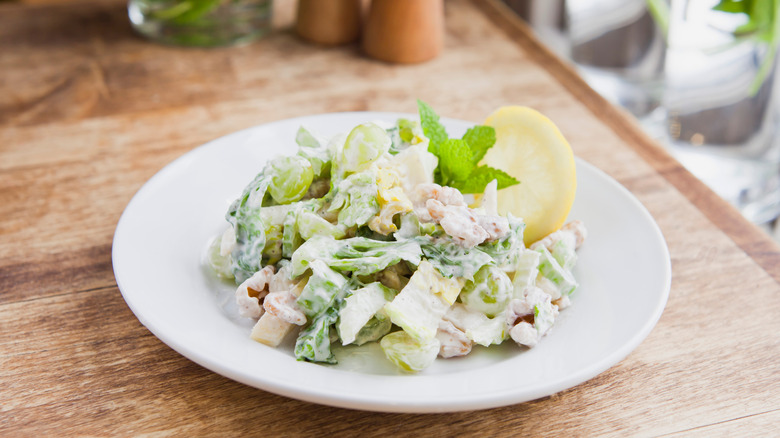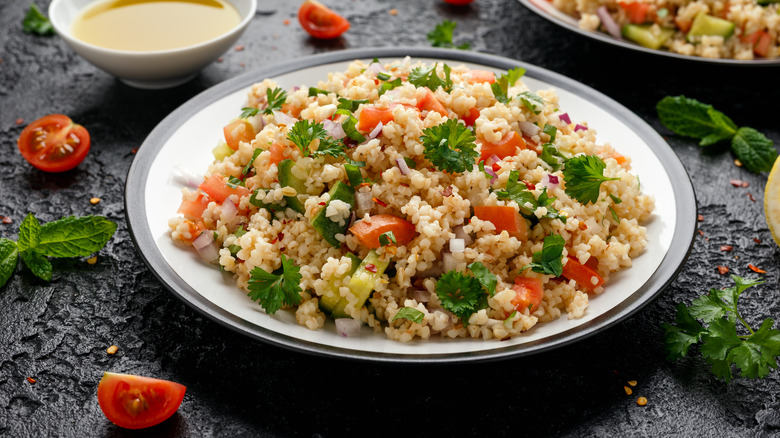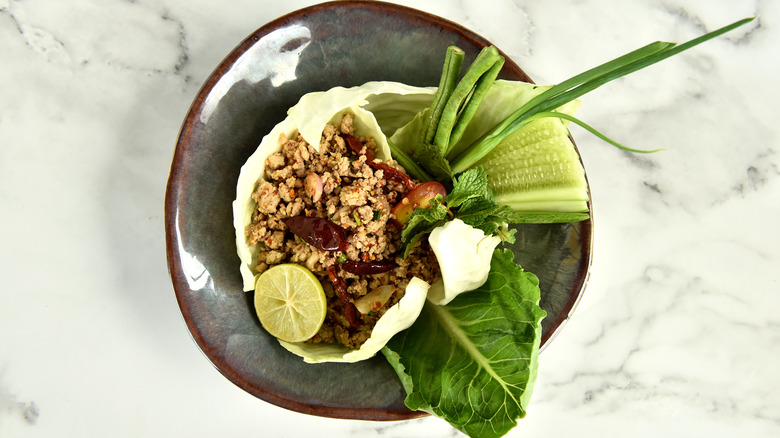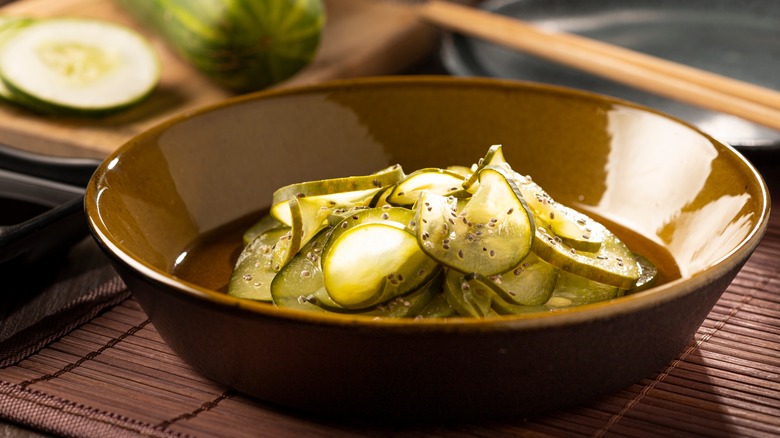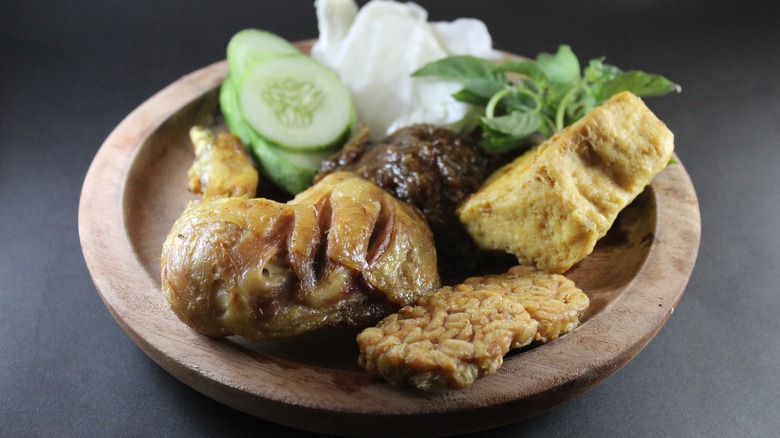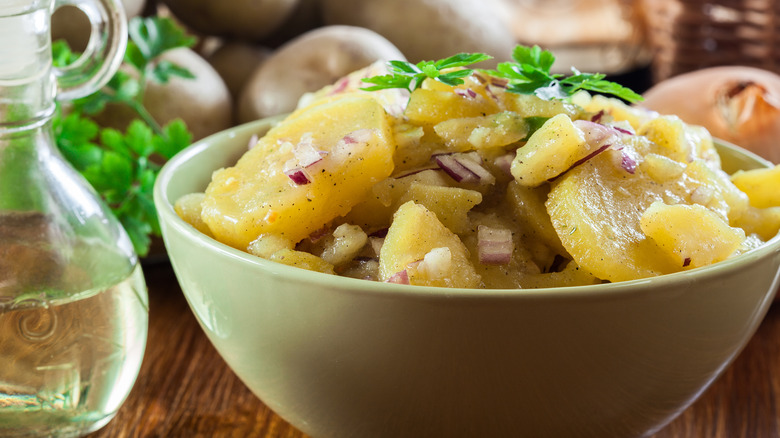The 14 Most Popular Salads In Different Countries Around The World
Salads can be a culinary adventure, providing a variety of nourishing textures and flavors. Imagine a bowl overflowing with nutrient-rich grains, tender greens, and juicy proteins. These dishes are sensory experiences that satisfy your hunger, as well as your taste buds.
The ancient Greek physician Hippocrates was a true pioneer when it came to recognizing the advantages of vegetable consumption. He identified the importance of eating raw vegetables, paving the way for the concept of salads. Modern research has confirmed (per The Washington Post) that the fiber in vegetables is vital for cultivating a healthy gut microbiome, which has far-reaching benefits for digestion, immunity, and overall wellness.
But what about when you're tired of lettuce? The great news is that there's a whole world of vegetables out there, waiting to be explored. You might even discover your new favorite lunch. From Thailand's zesty papaya salad to France's hearty Niçoise, each country has a unique take on salad. Let's broaden your salad horizons and embark on a global culinary adventure.
Horiatiki — Greece
Greek summers bring vibrant produce, which is one of many perks of the Mediterranean climate. You can easily find juicy tomatoes, sweet peppers, and olives so salty you'll feel like you're floating in the Aegean. With all of these offerings, it's no wonder that the region is a foodie paradise.
If there's one thing the Greeks know how to do, it is keep things simple. Horiatiki salad is a Greek dish that embodies this simplicity. It consists of a mishmash of roughly chopped peppers and tomatoes, sliced cucumbers, Kalamata olives, red onion, feta, fresh oregano, and a generous drizzle of olive oil. The horiatiki salad — or Greek salad, as it's called — appears to have become popular in Athens, during the 1960s. Then, Greek tourists visiting the country started to take a liking to it.
The next time you're in Greece, we recommend sampling this humble-yet-heavenly dish. If you're making a horiatiki salad at home, do it with Greek finesse: get only the best seasonal produce.
Pipirrana — Spain
Pipirrana is a wonderfully light Spanish salad. It is popular in the southern Spanish regions of Murcia, La Mancha, and Andalusia. This flavorful dish is sometimes eaten by field workers, due to its simple list of ingredients.
It is traditionally made with fresh, locally-sourced veggies like juicy tomatoes, crisp cucumbers, and tangy onions. But it's the addition of poblano peppers that takes it to the next level, adding a slightly spicy kick to each bite. Since it's drizzled with olive oil, vinegar, and a pinch of salt, this salad celebrates the summer season in Spain. If you don't love slurping on a cold tomato soup, pipirrana is an excellent alternative. Pipirrana uses almost the same ingredients as the famous Spanish dish gazpacho.
Variations of pipirrana salad abound in Spain's southern coastline, with seafood such as tuna, cod, or shrimp complementing the classic tomato base. In some Spanish regions, pipirrana is often scooped out of the bowl using pieces of bread. If you're making pipirrana at home, try to remove seeds from your tomatoes and cucumbers before serving.
Caprese — Italy
Caprese salad is a star dish of Italian cuisine. It features an eye-catching group of iconic ingredients from the Campania region of Italy. Mozzarella, tomatoes, basil, and olive oil are all you need to create this light dish. When arranged on the plate in alternating order, Caprese salad mimics the actual colors of the Italian flag.
Despite its humble appearance, Caprese salad has a rich history. The salad is said to have been inspired by the art movement known as Futurism. This movement laid out new ideas for many aspects of culture, including food. In contrast to the heavier Italian pasta dishes, the Futurists embraced lighter and more vibrant recipes. In response to these new tastes, Caprese salad was dreamed up.
If you want to do the Italians justice, don't skimp on the ingredients. We recommend purchasing the creamiest mozzarella, juiciest heirloom tomatoes, and the finest extra virgin olive oil you can find. When it comes to basil, don't chop it up. Doing so can cause the leaves to lose their texture quickly. For a more playful presentation, consider using tiny mozzarella balls and cherry tomatoes. This variation can add a touch of whimsy to this classic dish. To make things even better, the ingredients in Caprese salad can be easily adapted to other beloved Italian dishes. Don't be afraid to use them in your next pizza, pasta, or panini.
Salade Niçoise — France
Salade Niçoise is named for the French city of Nice, where it originated. Many French individuals have strong opinions on how it should be prepared, according to The Washington Post.
The former mayor of Nice, Jacques Médecin, said that the salad must not include cooked vegetables or potatoes. French food writer Fabien Gruhier also had opinions about the salad. Gruhier thought that black olives, tomatoes, white onions, cucumbers, garlic, basil, and green peppers are required to make it. He also recommends using either tuna or anchovy filets, as well as lima beans or artichokes. No other ingredients should be included. Just from these two different stories, you can tell that there is clearly some variation involved.
The time you're served Niçoise salad in your local French restaurant, know it's most likely an interpretation decided by the chef. While there may be a few disagreements on how it should be made, salade Niçoise's status as an iconic French food is undeniable.
Caesar salad — Mexico
Caesar salad has an intriguing history. Tijuana, Mexico is the birthplace of this iconic salad. It was invented at the Caesar Hotel, located in Tijuana. The story goes that a group of American soldiers arrived late one night, hungry for food. The cooks went into the kitchen, rummaged through the pantry, and threw together whatever they could find. From this random group of ingredients, the Caesar salad was born.
It became popular during the Prohibition Era when Hollywood stars would cross California's Southern border looking for booze. They often stayed at Tijuana's Caesar Hotel, where they ended up trying the famous Caesar salad.
Over time, restaurants all over started serving Caesar salad. Crispy romaine lettuce, savory parmesan cheese, intense dressing, and crunchy croutons come together in a flavor explosion that's tough to resist. Anchovies were not part of the original recipe but were later added in. The key to making the best Caesar salad is to keep those lettuce leaves whole, then gently toss them with the dressing. If you need some more protein, adding some grilled chicken makes the dish even more satisfying.
Coleslaw — United States
Coleslaw is a type of cabbage salad that's been an American staple for decades. It's said to have taken inspiration from a dish from the Netherlands. There, a similar cabbage dish was dressed with vinegar instead of mayonnaise.
In the U.S., creative cooks are known to take this creamy classic and give it their own unique twist. Whether you prefer an Asian-inspired slaw or a vinegar-dressed salad with apple and fennel, the essence of coleslaw always shines through. The refreshing crunch of cabbage and carrots makes it the perfect accompaniment to grilled meats, burgers, or potatoes. It's also affordable, making it all the more convenient.
Some people may have a mayonnaise phobia, but does that warrant coleslaw a smear campaign? This crunchy classic deserves a fair trial. Coleslaw is a dish with a rich cultural history. We should give coleslaw a second chance and appreciate it for the flavorful sidekick it truly is.
Macaroni — United States
Macaroni salad, a type of pasta salad, started to become popular in America during the 20th century. But it wasn't until the 1960s and 1970s that this carb-loaded salad started to really take off.
Hold on to your forks because there is a difference between macaroni salad and pasta salad. Macaroni salad is made from elbow-shaped noodles slathered in a creamy mayonnaise-based dressing. Pasta salad could be considered macaroni salad's more sophisticated cousin. In this recipe, cold noodles are dressed in a tangy vinaigrette, then mixed with things like olives and cucumbers.
If you're wondering where macaroni salad reigns supreme, look no further than Hawaii. In this tropical paradise, macaroni salad is a lunchtime hero. It's used to complement a protein of choice. The mayonnaise used for Hawaiian macaroni salad is often thinned with milk to make the dressing more palatable. But that's not all. A few essential ingredients like carrots, red onion, vinegar, and Tabasco take this salad to the next level.
Som tam — Thailand
Green papaya salad — called som tum or som tam — is an unforgettable dish from Thailand. The soulful salad is most often associated with Thai food, but it has connections to nearby countries like Laos, Vietnam, and Cambodia. Each country has its own unique spin on the dish. Whether you're looking to elevate your lunch routine or explore new flavors, green papaya salad is a must-try meal.
Som tam is usually made from a combination of Thai chilies, fresh garlic, dried shrimp, fish sauce, sweet palm sugar, peanuts, juicy limes, cherry tomatoes, and long green beans. All of these get expertly blended together to create the perfect balance of sweet and sour, as well as salty and spicy.
But the real showstopper is crisp and refreshing green papaya. This is the salad's main ingredient and it adds an irresistible crunch to every bite. Several ingredients — excluding the green papaya, long beans, peanuts, and tomatoes — are usually tossed into a mortar and crushed into a bold-tasting paste that gives the salad its distinctive flavor. In some preparations, cooks add some shredded carrots for extra color and texture. The secret to success is avoiding overripe papaya. You don't want the fruit to be too soft, as its crunchiness makes this dish.
Waldorf — United States
Waldorf salad is a historic dish that was once served to wealthy Americans. It was born from the creative mind of Oscar Tschirky, who worked at the luxurious Waldorf Astoria hotel in New York City. It's said that Waldorf salad was invented for a charity event that took place at the hotel in 1893. The original recipe featured an irresistible mix of fresh apples and crispy celery tossed in a creamy coat of mayonnaise. Walnuts later became a staple of this dish.
This dish has come a long way since its inception at the Waldorf Astoria. Chefs and home cooks worldwide have used it as a canvas for their interpretation, resulting in endless variations. From mandarin oranges to marshmallows, the Waldorf salad has seen it all.
The hotel's version of the salad was updated in 2011. It was then changed to be made with candied walnuts, red grapes, and green grapes. The dressing was also transformed. The simple condiment choice of mayonnaise was switched to a truffle-flavored crème fraîche. The Waldorf salad is anything but old-fashioned. No matter how you toss it, it always strikes the perfect balance between sweet and savory.
Tabbouleh — Lebanon
Tabbouleh, a traditional salad hailing from Lebanon, is a proud ambassador of the country's culture. It often graces mezze platters worldwide, rubbing shoulders with hummus and falafel. It has traveled far and wide, yet its heart remains in Lebanon, where it is relished as a food staple.
The secret to tabbouleh's delectable taste lies in its combination of finely chopped parsley, tomato, onion, mint, and bulgur. All of these ingredients are seasoned with a zesty mix of lemon juice and olive oil. The taste of this unique salad improves with time, so be patient.
This salad has become a favorite among vegetarians, as it's very nutritious (per Livestrong). The secret to a mouth-watering tabbouleh salad is using fresh herbs and lemon zest. These refreshing flavors make it the perfect accompaniment to traditional Arabic meat dishes. Don't settle for the mundane. Take your taste buds on an adventure with Lebanese tabbouleh.
Larb gai — Laos
If you're in the mood for a truly Laotian experience, larb gai is for you. This meaty salad with explosive flavors is Laos' national dish. Bursting with fragrant Asian herbs and spices, larb gai is a unique culinary experience that stands apart from other salads. It is popular in both Laos and Thailand. Both countries use a generous amount of chili to give this dish its fiery kick.
Larb gai is traditionally eaten with refreshing cabbage or lettuce wedges. It's all about the protein. Minced chicken is a favorite Western choice, but it's traditionally made with pork. If you're making it with chicken, thighs are the preferred cut, as they contain just the right amount of fat.
But that's just the beginning. This salad is also made with toasted fragrant rice, kaffir lime leaves, and the spice galangal. Meanwhile, the addition of palm sugar mellows things up a bit. Finally, you'll want to add a generous squeeze of lime juice to balance the sweetness. It's worth noting that larb gai is best eaten immediately, so be sure to dig in while it's still fresh.
Sunomono — Japan
Sunomono is a simple and refreshing side dish that accompanies many traditional meals in Japan. The beauty of sunomono lies in its versatility. You can dress up a variety of vegetables with rice vinegar or a zesty lemon-based dressing. While the choices are endless, Japanese cucumbers are a top pick. This is due to their crunchiness and almost sweet flavor. For added depth, seaweed ingredients like wakame are often thrown into the mix, creating a perfect balance of sweet and salty. Finally, sesame seeds are added, contributing a subtle crunch to this delightful salad.
This salad is more than a regular side dish in Japanese cuisine. It's also a superfood with many health benefits. According to a study published by Science Daily, regular consumption of sunomono can significantly lower blood pressure, thanks to its vinegar. Not only does this taste good, but incorporating this into your daily diet may improve your overall health.
Pecel — Indonesia
Pecel is a traditional Indonesian vegetable dish made with a fragrant peanut sauce. Although quite simple, the dish is anything but boring.
Originally from the beautiful island of Java, pecel is a dish available in many variations across Indonesia. Usually, the meal is served with long beans, cabbage, spinach, and bean sprouts. But you can get creative with vegetable choices. Locals often pair pecel with other foods, such as rice cakes or meat, to make it a more substantial meal.
The dish's star is undoubtedly the sauce. It's a perfect marriage of crunchy peanuts, fragrant kaffir lime, and kencur — a plant related to ginger that gives the salad its unique, intense aroma. This sauce is crushed into a paste. Tamarind and palm sugar are also added, providing a tang, while bird's eye chilies bring the heat. This thick paste is usually diluted with water before drizzling over vegetables to make it more spreadable. If you ever decide to make pecel at home, the elusive kencur might be tricky to find, but it's worth hunting down.
Potato salad — Germany
Potato salad is a salad dish enjoyed worldwide, but no one does it quite like Germans. They take their potato game seriously. Many families even have their own potato salad recipe. Unlike the American version which is usually made with mayonnaise, the German version is a flavorful combination of vinegar, mustard, herbs, spices, and potatoes.
To achieve this perfection, you need to pick the proper spuds. Look for Yukon gold, Ozette, and Reine varieties. Once you have your potatoes, cook them with the skin on. Next, chop each potato into thin, round slices. Finally, it's time to make the sauce. Mix water, white vinegar, salt, white pepper, and neutral oil to make an emulsion. Then, add a little extra bite by adding some finely chopped white onion. Want to get fancy? Toss in some smoked bacon, pickles, fresh chives, or parsley. If you crave a kick, add more mustard.
